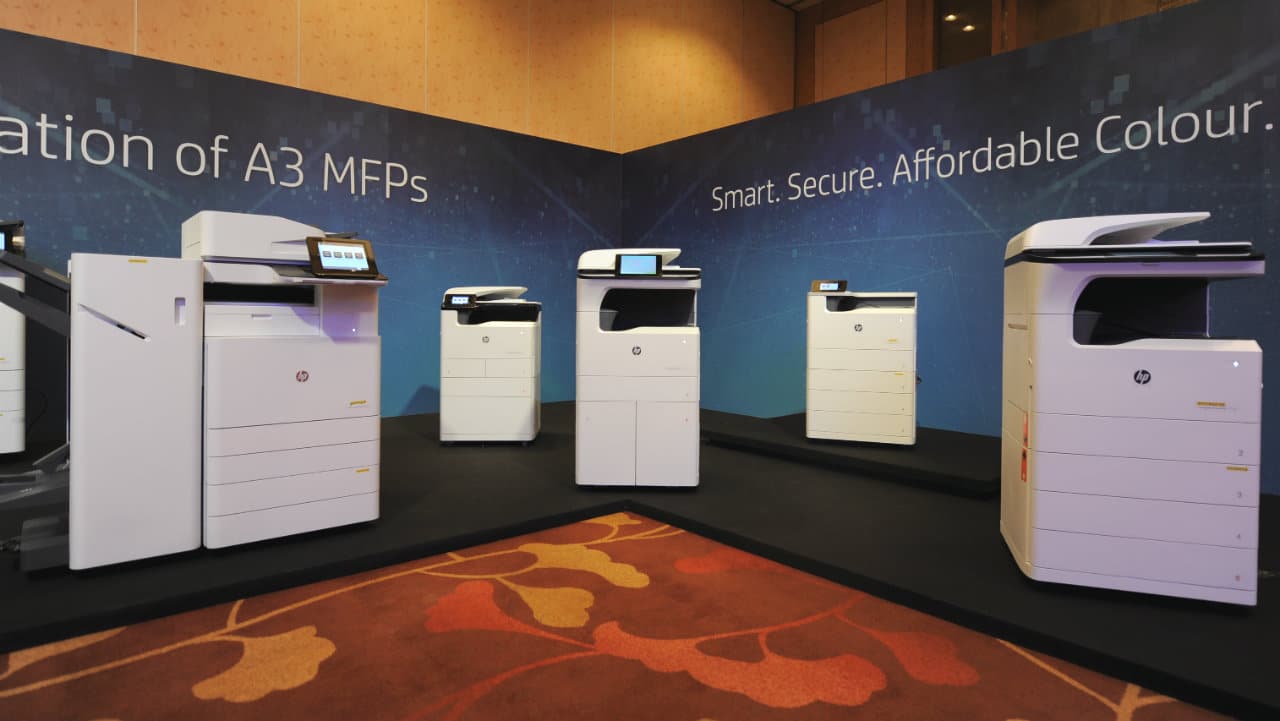Enterprise
HP A3 MFP helps protect your workplace from cyber attacks

Your office is vulnerable to a cyber attack and you don’t even know about it. HP, which positions itself as an advocate of security, has pinpointed the vulnerability — printers.
It seems ludicrous to think an entire office could be in danger from a cyber attack through a printer, but HP has done its homework and with the Internet of Things (IoT) becoming more and more prevalent in offices worldwide, the connected printer has become some sort of a backdoor hackers can go through if they please.
Identifying the threat, HP launched a family of A3 printers built to withstand and guard against these attacks.
In case you’re unfamiliar, A3 printers are like all-in-ones. They function not just as printers, but also as copiers and scanners.
Secure the workspace
Security is at the forefront of what drives HP’s efforts. Every day, offices print details from the mundane to the most confidential. The company wants to make sure these files are secure with printers that have built-in security features.
The printers today, connected to the network, are just like computers. And like computers, they are susceptible to attacks. This isn’t something HP just made up. In the “Annual Global IT Security Benchmark Tracking Study,” released by privacy and security body Ponemon Institute back in 2015, it noted that 60 percent of attacks at that point had a printer data breach. Too high a number to ignore.
HP’s printers have four layers of protection. First is HP Sure Start: It validates the integrity of the BIOS code. If the BIOS is compromised, HP defaults to a safe copy of the BIOS.
Next is whitelisting. This ensures that only codes authenticated by HP — those that have not been tampered with — are loaded onto the memory. If the printer detects an anomaly, the device automatically reboots.
HP’s JetAdvantage Security follows it up by checking and fixing any affected device security settings. To round it up, HP has partnered with machine data company Splunk for continuous monitoring that will detect anomalies during complex firmware and memory operations. If there’s an attack, again, the device shuts down and automatically reboots.
The protected printers
All of HP’s Enterprise 600 Series devices are equipped with these security features. Other than the notable security, the printers all offer the latest of HP’s printing technologies. HP Inc.’s Printing Systems General Manager for Asia Pacific and Japan, Ng Tian-Chong, was excited to share how this new line of printers all of have the new JetIntelligence capabilities built in starting at the toner particle level. These devices can wake up out of sleep mode and start their full operation in as fast as nine seconds. Fast, safe, and efficient.
The new line of printers also come with a modern, tablet-like user interface making it easier to navigate the device’s functions.

User-friendly. HP’s new line of printers are equipped with keyboards and a tablet-like user interface.
The devices are also built with easy repair and maintenance in mind. The Enterprise 600 Series are all equipped with sensors and real-time monitoring from Splunk, enabling HP to determine which units actually need onsite repair and which do not, saving both them and their client valuable time and resources.
Extending their market share
Tian-Chong elaborated on HP’s aggressive approach on A3. He said there are two primary big printing segments — A3 and A4. Both have a market of around 55 billion. In A4, they already lead the market share that they built through the years. That is not the case with A3. Their value proposition as they try to gain ground in the market? You guessed it: Security.

HP Inc. Printing Systems General Manager for Asia Pacific and Japan, Ng Tian-Chong, on stage during the Secure The Workspace event
Sure, it might cost more now, but Tian-Chong argues spending on security now can help make sure your company continues to exist and prevents a major hacking scandal. The value offered is more for the long term.
Nothing drives the point better than their web series entitled “The Wolf” starring award-winning actor Christian Slater. You’ll get major Mr. Robot feels watching, and HP studios has done a great job using this medium to explain how the vulnerabilities exist and why the printers have to be protected.
Reaching out to governments
From a security standpoint, it was clear that governments had the most to gain from this technology. After all, they hold the most confidential information there could possibly be.
We asked what HP is doing to reach out to governments to introduce this technology, and Managing Director for Southeast Asia, Koh Kong Meng, said they, together with their partners, have had “discussions with cyber security agencies here [Southeast Asia] to educate governments and discuss the risks.”
HP on their role in reaching out to governments to introduce printer security. #securetheworkspace pic.twitter.com/8lZYZzUNrN
— GadgetMatch (@gadgetmatch) June 6, 2017
Security, security, security
The whole event for the new printers talked more about security than anything else. Rightfully so, it’s the most compelling selling point of this new line. A quick Google search on “printers hacked” will yield results of actual printer hacking cases. The threat is real and HP wants to address it.
HP’s A3 multifunction printers (MFPs), as well as the 600 Series MFPs that include up to 17 SKUs with 26 available bundles ranging from 50ppm to 75ppm, are now available through qualified channel partners or directly from HP.
An increasingly connected environment also means an environment hackers can exploit. One unprotected device could spell disaster, and this latest effort from HP wants to prevent that disaster.
SEE ALSO: HP’s new line puts premium on office productivity
[irp posts=”11673″ name=”HP’s new line puts premium on office productivity”]

For the longest time, Google kept Pixel and Android behind two different teams. While the Pixel team dealt with devices made by and for the brand, the Android team ships a product meant for brands outside of the company’s purview. However, the days of separation are at an end. Google is officially merging its Pixel and Android teams together.
In a shocking announcement, the company has confirmed that the teams handling hardware and software will fall under a single team headed by Rick Osterloh. Prior to the merge, Osterloh was the senior vice president of devices and service, which was Google’s hardware branch. He will now oversee both hardware and software.
Because of the new leadership change, Hiroshi Lockheimer, former head of Android, will now move on to other projects within Alphabet. Of note, the change is not harsh for Lockheimer. He and Osterloh had been contemplating on the merge for a while.
Now, why the change? As is the case with everything today, it’s all because of AI. Speaking to The Verge, Osterloh explains that the merge will help with “full-stack innovation.” With how technology is these days, it’s now impossible to develop AI without having a close eye on hardware, such as in Google’s AI developments for the Pixel camera. Merging the teams will help streamline development, especially when hardware is involved.
Despite the change, outside brands, like Qualcomm’s Cristiano Amon, remains confident of Android’s capabilities outside of Google. Just expect more AI coming out in the near future.

The ongoing trade war between the United States and China is putting a lot of companies out of business in one country. While all eyes are currently on America’s crusade against TikTok, China has launched a salvo of its own. The country has started banning AMD and Intel, starting with government devices.
Recently, as reported by the Financial Times, China has introduced a new rule that bans American chipsets and servers from government agencies. The new ban includes AMD, Intel, and Microsoft Windows.
In lieu of the now-banned brands, Chinese government agencies must use approved brands from a list of 18 Chinese manufacturers. Unsurprisingly, the list includes Huawei, another brand involved in the ongoing trade war. (Huawei is still banned on American soil.)
As with bans from America, China’s latest rules stem from a desire to implement national security. Both countries allege that using brands from the opposing side will open a potential avenue for transferring classified information.
Currently, the ban against the American chipsets are only affecting government devices. However, if it follows the same trajectory as Huawei and TikTok in the United States, a government-only ban might soon lead to an all-out ban on consumer devices. As TikTok is currently hanging in the balance, it’s unlikely that the trade wars will cool down anytime soon.

So far, Apple’s greatest enemy has been the European Union. Months and months of claiming that the company engages in anti-competitive practices, the region has successfully caused Apple to drastically change a lot of things about the iPhone including the Lightning cable. Now, a new challenger wants Apple to answer for its supposed grip on the industry: the United States government.
Today, the Department of Justice is officially suing Apple for supposedly monopolizing the smartphone industry and stifling competition. The lawsuit alleges that Apple’s lineup of products prevent users from trying out other brands. For example, Apple limits how well a third-party smartwatch works on an iPhone, pushing users to go for an Apple Watch instead.
The lawsuit also includes an important pain point in Apple’s fight in Europe. It says that the company makes it difficult for iPhone users to communicate with Android users (and vice versa). Late last year, the company already committed to supporting RCS as a messaging standard, finally easing communication between the two systems. Their adoption has yet to arrive, though.
Though not as stringent as Europe, the American government is no slouch when it comes to questioning its own companies for pursuing anti-competitive practices. In the past, it went through Google and Spotify to protect the interests of its citizens. The lawsuit against Apple is no different, gathering signatures from sixteen states.
For Apple’s part, the company aims to get the case dismissed, alleging the lawsuit’s unfair scope of just the American people when it targets the entire world.
SEE ALSO: Apple opens first Developer Center in Southeast Asia
-

 Events2 weeks ago
Events2 weeks agoStellar Blade: PlayStation taps cosplayers to play Eve for game’s launch
-

 Features1 week ago
Features1 week agoFortify your home office or business setup with these devices
-

 Gaming2 weeks ago
Gaming2 weeks agoThe Rogue Prince of Persia looks like an ultra-colorful roguelite
-

 Accessories2 weeks ago
Accessories2 weeks agoLogitech unveils G Pro X 60 gaming keyboard: Price, details
-

 Reviews1 week ago
Reviews1 week agorealme 12+ 5G review: One month later
-

 Gaming2 weeks ago
Gaming2 weeks agoLenovo confirms development of a Legion Go 2
-

 Deals2 weeks ago
Deals2 weeks agoTCL P635 TV: Big savings for TCL’s anniversary
-

 Gaming1 week ago
Gaming1 week agoNew PUMA collection lets you wear PlayStation’s iconic symbols



























